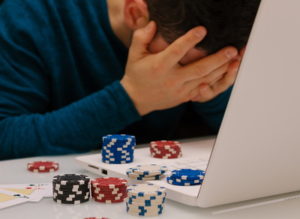 For gamblers of all types, one of the most important aspects to look at is your own personal bankroll management. Whether you are a poker player working out the cost of hands, a sports gambler placing bets or someone who plays casino games, you need to know how to manage your bank correctly to avoid any issues.
For gamblers of all types, one of the most important aspects to look at is your own personal bankroll management. Whether you are a poker player working out the cost of hands, a sports gambler placing bets or someone who plays casino games, you need to know how to manage your bank correctly to avoid any issues.
As a poker player, bankroll management should be a part of your overall strategy and something that you can keep a track of to ensure things are moving in the right direction. If you are an occasional player with small stakes, this is less important, but all players should know and understand bankroll management, and if you can implement it properly then even better.
Bankroll management is essentially managing the money that you set aside to play poker. This is known as your bank, and it is from here where you will pay for your stakes. This money should be completely separate to anything else you have, specifically in place for poker gaming and nothing else.
The reason players have a bankroll is to help with the risk of ruin. This is a short term bad run of luck, that your bank should allow you to ride, without one of these, you may not ride it out and lose your money. An important element of having a bankroll is the stakes you place, and there should be a strategy in place to change these as your bankroll changes, this can be to increase or decrease them, depending on how your gaming is going.
Implementing Bankroll Management
 When we are talking about poker terms, something you will pick up early into your time as a player is that when people are talking about variance, they are actually talking about luck. It is true that players will have runs, and these will be both good and bad.
When we are talking about poker terms, something you will pick up early into your time as a player is that when people are talking about variance, they are actually talking about luck. It is true that players will have runs, and these will be both good and bad.
It is important to note both styles when you are thinking about bankroll management and the risk of ruin. When you are on a good run, there is a temptation to up your stakes but remember that this will put you up against better players on the bigger staking tables. You haven’t improved yourself to get to this point, you are simply going through a run of good luck.
Get this wrong, and then go instantly on a bad run and that could have serious implications on your bank. This is why proper bankroll management is needed, you need to have enough to swallow the bad runs and also ensure you are sensible with stakes to make the most of your good runs.
Any changes in stake need to be done in line with changes to your bank, and they should have thought and process behind them, rather than being random, large increases. Lowering stakes is also an option for those who are struggling, don’t be scared to do this, as it will allow you to slowly regain control, and limit what you lose during a bad spell.
What is Risk of Ruin?
 The Risk of Ruin (ROR) is a term that professional and high-staking poker players use. They use this to explain the probability of them going bankrupt. Remember, this refers to their poker-only betting bank, a set amount of money put aside for playing.
The Risk of Ruin (ROR) is a term that professional and high-staking poker players use. They use this to explain the probability of them going bankrupt. Remember, this refers to their poker-only betting bank, a set amount of money put aside for playing.
Your ROR is given out as a percentage probability. For example, if your ROR is 1% then this means that you have a bankroll in place, you are playing with similar stakes and winning on a regular basis. There is a 1% chance that you will lose enough games consecutively to lose your entire bank.
In terms of what your Risk of Ruin figure will be, there is a simple way to work out how this goes. When you have a large betting bank, you are able to absorb more losses than normal, this means that your risk of ruin is incredibly small, like the 1% chance above.
However, when you have a smaller betting bank, and your stakes are larger in comparison to your bank, it won’t take as long for you to lose your entire bank, so the chances of this happening are much higher, and that means a higher percentage.
If you think of your play to look at this, you will understand it easier. Let’s say your average stakes are $10, and you have a betting bank of $1000. If you lose $10 per game, then you are going to need to lose 100 times in a row to lose $1000, which would leave you bankrupt and unable to continue.
The chances of losing 100 times in a row at poker, even as a beginner player, are incredibly slim, as you will eventually find yourself with a good hand that can help you get a win. This means a very small percentage will be in place as your Risk of Ruin.
If you have the same $10 stakes and your betting bank is smaller, let’s say $100, then this changes things dramatically. These figures mean that you will only need to lose 10 times to lose your entire bank, and the chances of 10 losses in a row are far higher than 100, so this would be shown by a much higher ROR percentage.
Strategies to Use with Risk of Ruin
 The biggest way you can work with Risk of Ruin and implement a strategy to help is with the stakes you are playing. Of course, raising hands, folding early and how long you are in a game will all affect this, so this can only be estimated, and is usually done by changing the blind amount on the table you play.
The biggest way you can work with Risk of Ruin and implement a strategy to help is with the stakes you are playing. Of course, raising hands, folding early and how long you are in a game will all affect this, so this can only be estimated, and is usually done by changing the blind amount on the table you play.
Every move you make needs to be carefully considered, as the wrong move can quickly eat into your bank more than you normally would. However, in terms of growing as a player, if you change stakes and slightly increase them when your betting bank allows, then if you get this right, you should only move further forward and make more profit.
One strategy that some people implement is to use a percentage of their betting bank as their rough stakes when playing poker. This achieves two things as you start playing and your bank changes. The first is that if you are doing well, and you are increasing your betting bank, stakes will also increase, which could lead to further success and even more profit.
These are changed in line with the betting bank though, so you are not going over and above what you should be spending, you are still spending the same amount of your bank, but as a percentage, rather than a monetary figure. If things go wrong while you are doing this, then as you lose some of the bank you have built up, your stakes will fall back to the original stakes you had at the start.
Secondly, if you go on a losing run and your bank is decreasing, then your stakes will decrease in line with that. This may not be ideal for everyone, as some players believe in trusting your bank to absorb the losses and keeping at the same level, as you will eventually get them back if you have the right strategy. However, some players will feel comfortable with this, so this element of the strategy is probably best left to personal choice.
